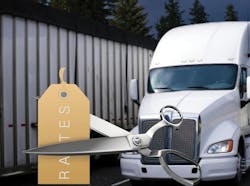Trucking hauling rates are volatile and ever-changing—and based on multiple influences. Some of these influences are controllable and others are not, with the majority fitting into the noncontrollable category. There are fuel prices, costs of doing business, driver pay, etc. Then there are broad market forces, competition for loads, other specific market forces such as availability of loads to the number of available trucks to haul them, and weather. All of these will impact the hauling fee you must calculate to remain profitable.
However, the one area that both infuriates and frustrates the smaller carriers is the use of volume discounting, which is a pricing strategy that crosses through most industries. The idea is the more product or service a particular customer purchases, the lower the price they pay per unit. This works great for widgets, but it’s very difficult to implement into a freight hauling pricing strategy. Why?
Well, in widgets, manufacturing capacity can always be increased because there are no time and mileage regulations hindering increased production. That becomes a major stumbling block in trucking, especially for the micro- and small motor carrier.
Large and mega-carriers with hundreds or even thousands of trucks have the capacity. Add to this volume their ability to create from those same trucks other revenue streams through lease-purchase programs from their drivers. Even when the trucks aren’t rolling with paying freight, they’re still earning revenue through lease payments and fees charged to their lease purchase operators.
Additionally, big fleets also use these lease-purchase trucks as collateral leverage for operating and expansion credit and as depreciable equipment on their tax returns—and they are self-insured. “We will make millions even if our profit margin is just a penny per mile,” quoted a CEO of a mega-carrier a few years ago.
Can micro- and small carriers counter this into a profitable freight hauling strategy?
An excellent read for your business bookshelf is The Profitmover’s Guide to Business Success by James B. Larsen. While this book focuses on the moving and relocation services part of the transportation industry, a lot of the author’s observations hold true for all of us.
The following quote from the book resonates with any business, especially a small one: “In a typical scenario, the company informs its salespeople that they can sell at a certain price or discount up to a certain percent to get the order. … What this really means is that salespeople are being allowed to set price without knowledge of what the actual cost is for the product or service they are selling. Does this make good business sense?”
No, frankly, it doesn’t—so don’t do it. There will always be a trucking company (usually one that is new and inexperienced) that figures the best way to line up shipping contracts fast is to undercut every other motor carrier out there. Sadly, they’ll be holding an auction to sell off tractors and office furniture before they realize they didn’t run their numbers to know their costs nor did they have a business plan in place to take the company beyond the first round of paychecks.
On the other hand, know the numbers you deal with day in and day out that determine the profitability of your company and whether it grows or stagnates. You’ve got to understand the fixed, operational and load-specific costs of every piece of equipment that moves under your company name.
And to get ahead, you’ve got to remember that your salary and wages as well as those of your office staff are part of fixed costs (per day), while the volatile fuel costs are counted as operational costs (per mile). Profits are set back to grow the company, whether in two years or five.
Understanding your costs and knowing how to calculate your profitability (capitalization) into the hauling rate of each load is the only way to ensure the success of your company. Undervaluing your hauling rates will decrease the efficiency of your company. Offer too steep of a discount and you will undermine your ability to weather the downturns and equipment maintenance and failures, which are inevitable.
If you are working from a static per-mile rate that fails to take into account the time as well as the distance necessary to complete a load, then you are working with a formula towards failure. (Note: Your drivers are not regulated by the mile; they are regulated by time. When time is not a part of your pricing strategy, you will find your carrier on the short end of the revenue stick.)
Most shippers understand return on investment and other costs. Take the time to sit down with your ‘old reliable’ shippers and show them exactly how you arrive at the shipping costs on their invoices. My bet is they’d be impressed. Show them that not only do you know how to keep your stock rolling and get their products where they need to be on time and in perfect condition, but you also understand the dynamics of the entire logistics chain.
Maybe your pitch to shippers needs to be a short background lesson on how you figure your prices. Set up a Skype meeting for a short business presentation. Using a white board, show them how your fixed costs, operational costs, and load specific costs as well as time and miles are all crucial in your hauling rate pricing structure.
Your shippers won’t be left scratching their heads and wondering why their shipping rates went up. Show them why the customer service you provide has gotten a little costlier. Let them know you want their company to succeed just as much as they do. Price without the service is never a good deal for either the shipper or for the carrier.
Know your market rates, your truck-to-load ratio, your costs, and your profit margin to determine your hauling rate range.
